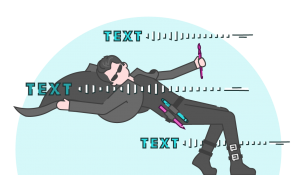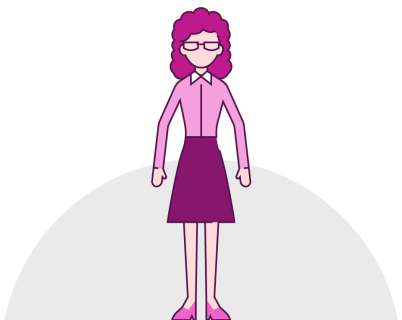Whenever we see a presentation filled with bullet points – either as audience members or presenters – our hearts sink. We just know it’s going to be a one-way ticket to boredom central. Deep down we all know that bullet points simply don’t belong in a presentation, but why do they always manage to worm their way back in? Well, let’s figure out why, and how we can stop them!
Warning: this article may include some mild ranting – please excuse it, but it’s good for the soul.
Bullet points and presentations: The back-story
In the good old days of presentations being run using blackboards and OHPs (overhead projectors) with acetate sheets, while bullet points were still used, as everything was hand written, it was often quicker and easier to use sketches and diagrams to illustrate the points being made. Not all presentation ‘slides’ were created during the presentation, but a reasonable number were.
Then came the digital age, with the rise of PowerPoint and LCD projectors. Everyone has fairly rapidly embraced this new technology, and yet the quality of the output was often worse, as PowerPoint actively encouraged everyone to ‘Click to add text’, and the default template was to create a series of bullet points. And like the sheep that we are, everyone followed this new format, without really questioning whether it was actually better.
Since then, as audiences have been to subjected to so much Death by PowerPoint, and presenters have really struggled to capture their audience’s attention, more people have begun to realise that going back to the old ways might actually be better. For some that means drawing, using white boards, or opening sketching apps. It’s not the technology that’s the problem though, but the use of text, rather than visuals.
Why don’t bullet points work: The science
But why is it such a big deal? Why do we find presentations full of bullet points so abhorrent? Well, you and everyone that you present to has more of their brain dedicated to processing visuals than any other sensory modality – in fact it’s thought that about 20% of the cortex is responsible for visual processing [Wandell, Dumoulin & Brewer 2007]. So when presenting, if you want to make sure that you get your audience to use their brains, it means using visuals.
And if you don’t like it, you can leave: The sceptics
Pretty much everyone gets this, but on a training course that I delivered last year (I’ve taken a while to write this so that I can a) calm down, and b) attempt to preserve anonymity), having gone through why visuals are so important, and getting everyone to agree to the fact, someone then asked the question,
“So how many bullet points would you recommend per slide?”
I was blunt and said that I would recommend no bullet points per slide.
“Oh yes, I know that you said about using visuals, but if I had to use bullet points, what would you recommend?”
The problem is that there is never a good case for using bullet points in a presentation (documents are a different matter), so there is no answer. You could have three bullets or a million, it would always be dreadful, as your audience can’t read and listen at the same time – we’re not wired to do it.
On our training courses, we show how you don’t need to be ultra-creative or artistic to create visuals, nor do you need wonderfully designed slides with all sorts of animations (but if you do, and want some help, let us know).
Anyone can, and should create simple visuals that help communicate with your audience.
And after repeating all of this to the delegate, I had to say “and if you don’t like it, you can leave” because there really wasn’t much point in doing anything else.
Probably a bit harsh with hindsight, but how anyone can try to go back to a bad way of presenting with such a large body of evidence against it, while at the same time knowing that there are easier and more effective alternatives is beyond me.
How to replace bullet points with visuals: 6 steps to success
What the delegate in my training course failed to understand was that not only is presenting with visual slides more effective, but it can also be much easier than filling a presentation with lots of slides covered in text. Using visuals allows you to be more succinct and to-the-point. It means you can cut a lot of the useless stuff that doesn’t help you persuade your audience, or train them in a skill.
So how do you do it? Here are six steps to get you started.
- Identify your objectives and then think about your audience. What do they need to hear to convince them to follow through with the actions that you suggest? What are the few key things that will demonstrate how your audience will be more successful and benefit from what you are asking them to do?
- Think about things entirely from your audience’s perspective and only add content if it’s important to your audience (which means that they benefit, or it helps them to see how they will benefit by doing something with you).
- With those points, then think about the three or four simple diagrams that will help them understand exactly those points. Don’t get lost with stuff about you, that’s often irrelevant. This helps you create simple, yet elegant visuals.
- Things like charts, processes, and timelines are easy simple visuals that everyone can create. Maybe push the boat out a bit and think about the interaction between your audience and you, or your product/service.
- Use stick figures to represent everyone, arrows to connect you, light bulbs, info icons, warning symbols, and ticks/crosses for really clear, simple ideas. Or go even further, and think about using different colours to represent things, use visual metaphors to tell better stories, link ideas using analogies, anything you like.
- Don’t let yourself be limited by PowerPoint – draw something on paper or a sketching app instead – and you’ll be amazed at how your visuals will start to come to life. And then, actually present with these sketches – or draw them out in front of your prospect.
And if that’s just whetted your appetite for more, I’ve gone into this process in much more detail in this article on creating visual presentations and eLearning.
You will be amazed at the impact that it will have, as you’ll gain massive credibility for knowing your stuff, and also be able to respond much better to your much more engaged audience.
If you then want to convert this to a presentation that everyone else can use, that’s when you might want to use PowerPoint, and if you need any help, let us know.
Leave a comment





Ironically there are no visuals here only bullet points !
It’s an article, not a presentation. Bullet points are fine in writing, just not for presentations.
Clear and enormously helpful. Thanks!
Is it really true that we are all bored when we see bullet points in presentations? I tend to disagree.